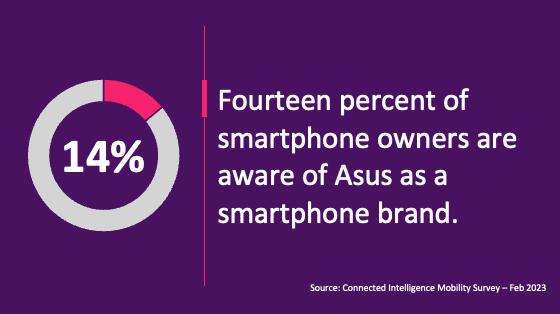
Asus Unveils the ROG Phone 7 Series
This month, Asus is launching its latest gaming-focused smartphones — the ROG Phone 7 and 7 Ultimate — in Europe and Taiwan. US availability and pricing has yet to be announced, but Asus does plan to release the devices stateside. The gaming phones come equipped with Qualcomm’s Snapdragon 8 Gen 2 processor to enhance gaming experiences, as well as the new GameCool 7 system to prevent overheating during use. They also comes with a detachable AeroActive Cooler 7 accessory with advanced cooling and a built-in subwoofer.
Aside from the physical features added for gaming, the phones will use AI to automatically recognize certain occurrences while the user plays games that support it. It will recognize patterns such as when the character is killed or emerges victorious. This AI is called the “X Capture” and uses Asus’ proprietary tools. Another AI feature called “X Sense” can deliver notifications with tips to guide players through a game.
The Circana Take:
- According to our Connected Intelligence Mobile Connectivity Survey, consumer awareness of Asus as a smartphone brand is 14%. The ROG Phone’s gaming focus makes it a less universal fit for prospective buyers. However, for those seeking out a gaming phone in particular, the AI, subwoofer and cooling features are unique draws.
- Not putting all prospects in one phone type, Asus does have another smartphone line as well, currently the ZenFone 9 with a rumored 10 on the way. The ZenFone 9 has more traditional — and in some cases nostalgic — features such as a smaller (5.9 inch) display and a traditional headphone jack. These, plus its sub-$700 price tag, make it a potentially attractive option for shoppers expanding outside of the top few smartphone brands.
Cars: The Next 5G Frontier?
Apple CarPlay and Android Auto have let drivers cast their smartphone content to car displays and speakers since their launches circa 2016. These platforms connect to use maps, music, and make calls through the vehicle’s interface, to name a few capabilities. But in many ways, this reduces the strength of the car OEM in building a unique look and feel for their car and we are starting to see a push-back. Tesla, of course, has never supported CarPlay, instead providing a direct interface through its own 5G (subscription) connection. And now we are starting to see additional car manufacturers, such as GM, taking a fresh look at the interface, and pulling away from phone-first interfaces. This way, the car manufacturers have more control over the user experience, and display aesthetics as well.
The Circana Take:
- The expansion of an existing philosophy to transition to the car becoming the connected device, rather than having an app transferring content through a smartphone, is a big opportunity for 5G-providing mobile carriers. The upside is additional 5G connections, a brand-new source of revenue.
- There are additional concerns when thinking in the position of consumer’s advocate. According to our Mobile Connectivity Survey, 25% of respondents who use their tablets on Wi-Fi only (not connected to LTE networks) report they do so because cellular data service plans are too expensive. There is a chance of backlash and uncertainty if they are faced with a responsibility to add a line of service for their cars. Half of our survey panelists report that in response to inflation and the current economic climate, they have or plan to cut back on mobile-related spending. It will be interesting to observe how carmakers and consumers act on these changes, and who will take on the cost for the service, including whether the auto companies will compensate.
- If consumers are charged with paying the 5G carrier fees for service in the car, could car mounts and other phone accessories reap the benefit instead? Would customers opt away from the in-car displays in favor of simply positioning their phone at eye level, the old-fashioned way?